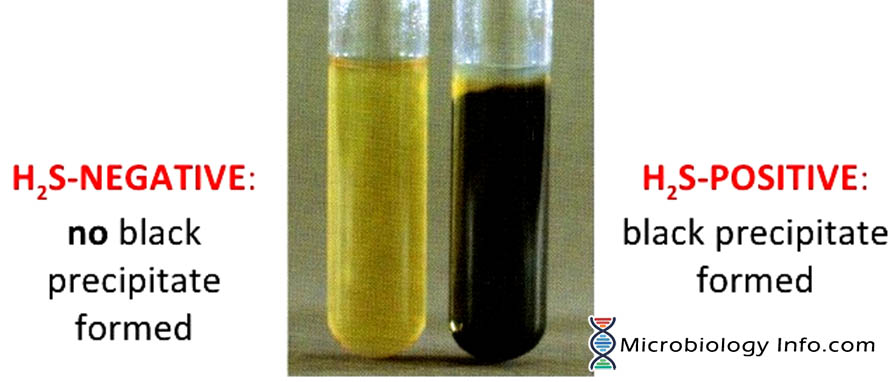SIM medium (Sulphide Indole Motility medium) which is a combination differential medium that tests three different parameters, Sulfur Reduction, Indole Production and Motility.
As the name suggests, it is commonly used to test a microbe for the ability to produce the gas hydrogen sulfide (H2S). The “S” in SIM stands for sulfur.
Objective
- To test for the ability of an organism to reduce sulphur
- To differentiate gram-negative enteric bacilli on the basis of sulfide production
Principle
Organisms which produce the enzyme thiosulfate reductase can reduce sulfur to hydrogen sulfide gas. This happens when the strain either degrades the amino acid cysteine during protein degradation, or when anaerobic respiration shuttles the electrons to sulfur instead of to oxygen. In the SIM tubes, the medium contains casein and animal proteins as amino acid sources, sodium thiosulfate as a source of sulfur and ferrous ammonium sulfate as the H2S indicator. Cysteine is a sulfur containing amino acid present in the SIM medium.
The enzymes cysteine desulfurase and thiosulfate reductase catalyze hydrolysis reactions that produce H2S. This gas combines with the ferrous ammonium sulfate forming an insoluble, black ferrous sulfide precipitate. The black color thus acts as an indicator for the presence of hydrogen sulfide.
In the laboratory, a fresh culture of the organism is inoculated with a single stab using straight needle through the center of the medium. Following incubation, the tube is observed for H2S production (blackening of the medium).
Media:
SIM Agar
Pancreatic digest of casein 20.0g, Peptic digest of animal tissue 6.1g, Agar 3.5g, Fe(NH4)2(SO4)2·6H2O 0.2g, Na2S2O3·5H2O 0.2g, pH 7.3 ± 0.2 at 25°C
Method
- Touch a straight needle to a colony of a young (18- to 24-hour) culture growing on agar medium.
- Stab once to a depth of only 1/3 to ½ inch in the middle of the tube.
- Incubate at 35°-37°C and examine daily for up to 7 days.
- Observe for blackening of the medium on the line of inoculation.
Expected Results
- Positive: Darkening of the medium (a black precipitate) or blackening of the line of inoculation indicates the presence of bacteria producing hydrogen sulfide.
- Negative: A negative H2S test is denoted by the absence of blackening.

Uses
- It is used to differentiate sulfur reducing members of the genera Salmonella, Shigella and Proteus from the negative Moranella morganii and Providencia rettgeri.
- The production of hydrogen sulphide is a useful diagnostic test in the identification of enteric bacteria.
Limitations
- The reactions given by SIM Medium are not sufficient to speciate organisms. Additional biochemical and serological tests are required for confirmation.
- The inoculum should be taken from a solid medium. Use of an inoculum from a liquid or broth suspension will delay the initiation of growth and may result in erroneous results.
References
- Tille P.M. 2014. Bailey and Scott’s diagnostic microbiology. Thirteen edition. Mosby, Inc., an affiliate of Elsevier Inc. 3251 Riverport Lane. St. Louis. Missouri 63043
- http://iws2.collin.edu/dcain/CCCCD%20Micro/sim_deep.htm
- https://www.austincc.edu/microbugz/sim_medium.php
- https://spot.pcc.edu/~jvolpe/b/bi234/lab/differentialTests/SIM%20Medium.html
- http://www.oxoid.com/UK/blue/prod_detail/prod_detail.asp?pr=CM0435&c=UK&lang=EN
- https://www.himedialabs.com/TD/M181.pdf
- https://catalog.hardydiagnostics.com/cp_prod/Content/hugo/SIMMedium.htm
- https://www.coursehero.com/file/p3orm5tu/Hydrogen-Sulfide-Production-and-Motility-SIM-Medium-is-used-to-test-a-microbe/

You don’t show (or discuss) the results of adding Kovac’s reagent — the indole part! I know you show indole testing elsewhere, but not with this medium.